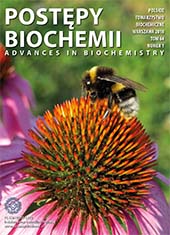50th anniversary of discovering „magic spots” â the latest advances in (p)ppGpp research
DOI:
https://doi.org/10.18388/pb.2018_93Abstract
About 50 years ago, „magic spots” â mediators of the bacterial stringent response, were discovered and were later identified as guanosine tetra- and pentaphosphate (ppGpp and pppGpp, jointly referred to as (p)ppGpp). At first, it seemed that stringent response is associated only with bacterial response to amino acid starvation, however, it soon turned out that (p)ppGpp is synthesized in response to other stresses as well. The mentioned alarmones are found to exist in all known bacterial species, as well as in plants. In recent years, a significant progress has been made in research on (p)ppGpp metabolism. It is also known that the stringent response affects many cellular processes, among which its effect on transcription is the best characterized. Moreover, (p)ppGpp is involved in the DNA repair pathway associated with transcription. In addition, the stringent response inhibits cell division, mainly by hindering DNA replication. (p)ppGpp is also of significant medical importance â it is necessary for virulence of many bacterial species and for turning them into persisters, i.e. cells which have elevated tolerance to many antibiotics.
Downloads
Published
Issue
Section
License
All journal contents are distributed under the Creative Commons Attribution-ShareAlike 4.0 International (CC BY-SA 4.0) license. Everybody may use the content following terms: Attribution — You must give appropriate credit, provide a link to the license, and indicate if changes were made, ShareAlike — If you remix, transform, or build upon the material, you must distribute your contributions under the same license as the original. There are no additional restrictions — You may not apply legal terms or technological measures that legally restrict others from doing anything the license permits.
Copyright for all published papers © stays with the authors.
Copyright for the journal: © Polish Biochemical Society.




